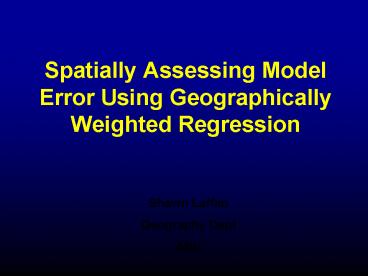Spatially Assessing Model Error Using Geographically Weighted Regression - PowerPoint PPT Presentation
1 / 25
Title:
Spatially Assessing Model Error Using Geographically Weighted Regression
Description:
high r2 means reliable b parameters and therefore reliable error measures ... spatial lag. Max r2. r2 = red. omission = green. commission = blue ... – PowerPoint PPT presentation
Number of Views:189
Avg rating:3.0/5.0
Title: Spatially Assessing Model Error Using Geographically Weighted Regression
1
Spatially Assessing Model Error Using
Geographically Weighted Regression
Shawn Laffan Geography Dept ANU
2
- Non-spatial methods are increasingly used to
model and map continuous spatial properties - Artificial Neural Networks, Decision Trees,
Expert Systems... - These can use more ancillary variables than
explicitly spatial methods - Usually assessed using non-spatial global error
measures - Summarise many data points
- Cannot easily identify where model is correct
3
- Error residuals may be mapped
- But usually points
- Difficult to visually identify spatial clustering
- Large point symbols
- no multi-scale
- no quantification
- Can use spatial error analysis to detect clusters
of similar prediction - Use these areas with confidence
- Areas with unacceptable error indicate need for
different variables or approach
4
- To spatially assess model error a method should
- Locally calculate omission, commission total
error in original data units in one assessment - one dataset each
- Assess error for unsampled locations
- generate spatially continuous surfaces for easier
interpretation - Provide confidence information about the
assessment - uncertainty estimate
5
- Possible approaches
- Mean, StdDev, Range for spatial window
- three attributes to interpret for each of
omission, commission and total error - mean will often not equal zero
- Co-variograms
- global assessment
- work only for sampled locations
- Local Spatial Autocorrelation
- Geographically Weighted Regression
6
- Local Spatial Autocorrelation
- indices of spatial association
- easy to interpret
- multi-scale
- calculate residuals and assess spatial clustering
- some indices calculable for unsampled locations
- Getis-Ord Gi, Openshaws GAM
7
- Local Spatial Autocorrelation
- Give difference from expected (global mean)
- mean will not normally be zero
- Must analyse omission commission separately
- partly cancel out
- leads to numeric and sample density problems
- confidence information
8
- Geographically Weighted Regression
- multivariate spatial analysis in the presence of
non-stationarity - perform regression within a moving spatial window
- multi-scaled
- can directly assess residual error without prior
calculation - simultaneous omission, commission and total error
assessment - estimates for unsampled locations
- r2 parameter gives confidence information
9
- The approach
- Ordinary Least Squares
- Y a bX
- calculated for circles of increasing radius
across the entire dataset - minimum 5 sample points
- no spatial weight decay with distance
- does not force an assumed distribution on the
data - optimal spatial scale when r2 is maximum
10
- Interpreting regression parameters for error
- error is the square root of the area between the
fitted and the optimal lines - this is bounded by the min and max of the
predicted distribution - as b approaches 1 the intercept approaches /-
infinity causing extremely large error values - use the intersection of the fitted line with the
optimal line (11, YX) to determine omission
commission
11
(No Transcript)
12
(No Transcript)
13
- The r2 parameter
- high r2 means reliable b parameters and therefore
reliable error measures - low values indicate low confidence caused by
dispersed data values - these areas cannot be used as b is meaningless
14
- Example application
- feed-forward ANN to infer aluminium oxide
- used topographic and vegetation indices
- 1100 km2 area at Weipa, Far North Queensland,
Australia - 16000 drill cores
- 30.4 accurate within /- 1 original unit
- 48.7 accurate within /- 2 original units
15
(No Transcript)
16
Subset of study area
17
Total error 4, 7 10 cell radius
18
Total
Omission
Commission
19
Optimal spatial lag
Max r2
20
Visualising error distribution with confidence
information
r2 red omission green commission blue
21
(No Transcript)
22
- Limitations
- sample density distribution
- outliers
- data spatial
- cause low r2
- landscape does not operate in circles
23
- Extended Utility
- can use the regression parameters to correct the
ANN prediction - similar to universal kriging but ANN allows for
the inclusion of more ancillary variables - have not taken into account r2 values
24
Comparison with universal kriging
25
- Conclusions
- GWR allows the spatial investigation of
non-spatial model error - calculates total, omission and commission error
in one assessment, with confidence information - identified locations of good and poor model
prediction in a densely sampled dataset - not immediately obvious without GWR
- currently exploratory
- significance tests would be useful































